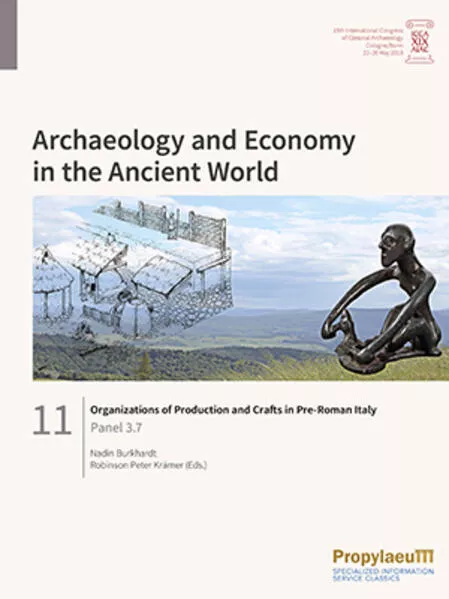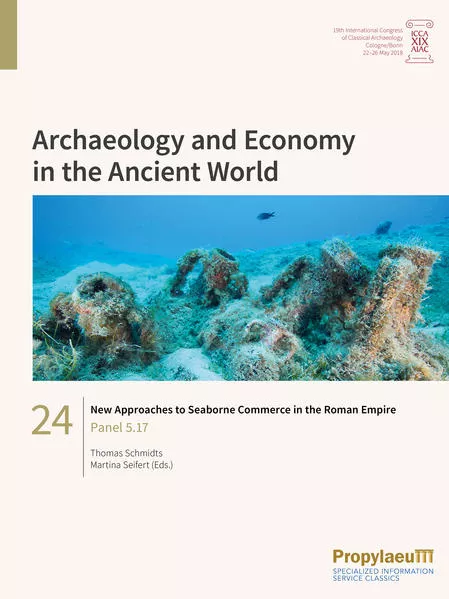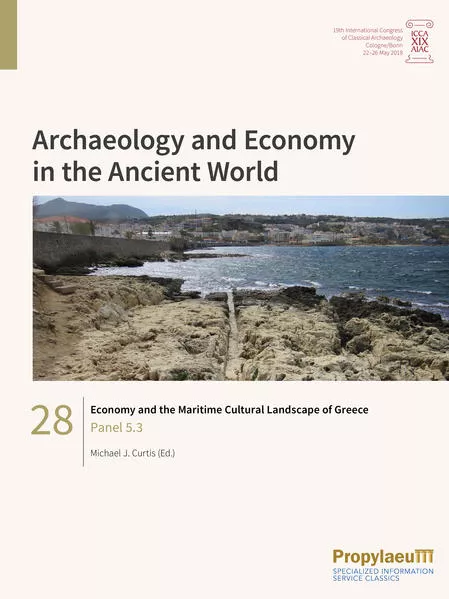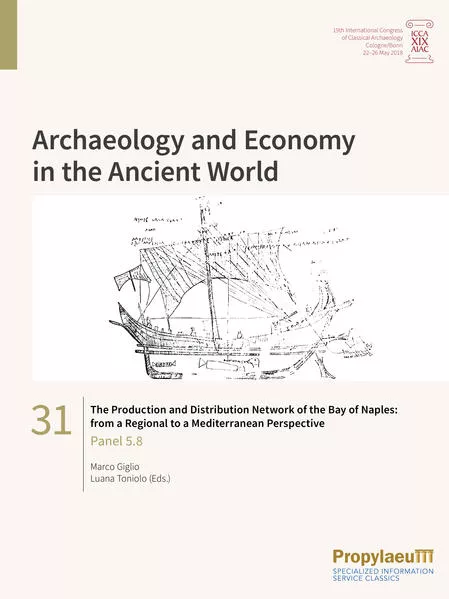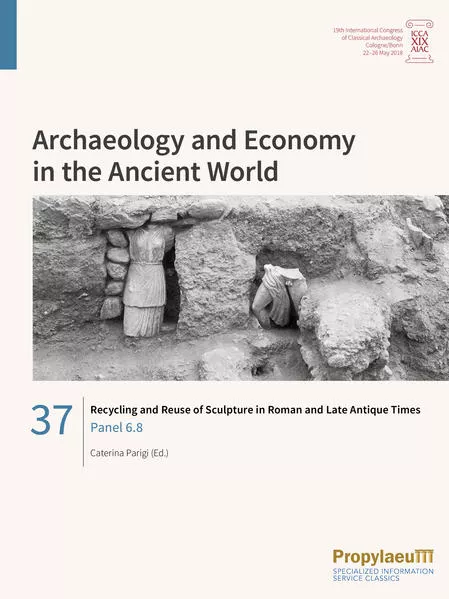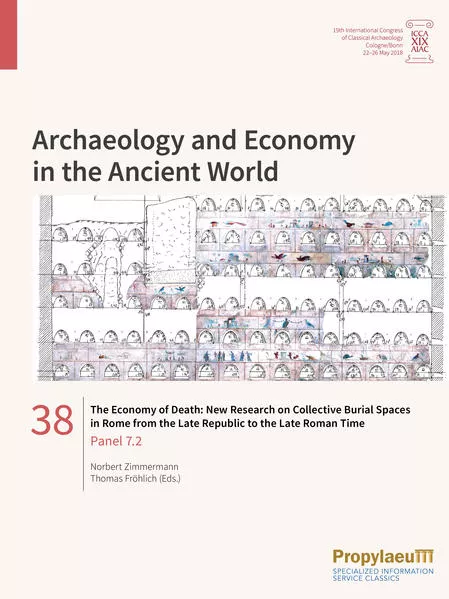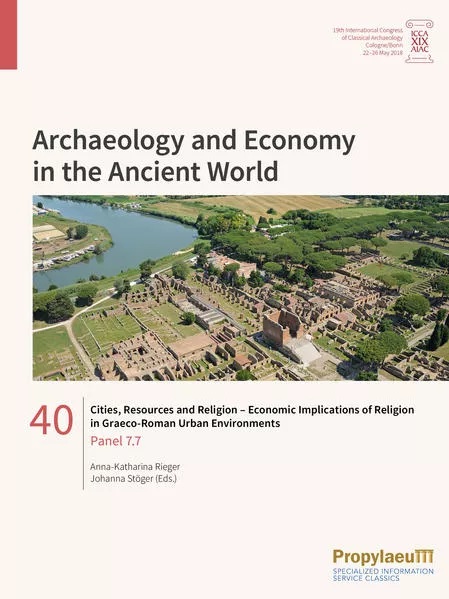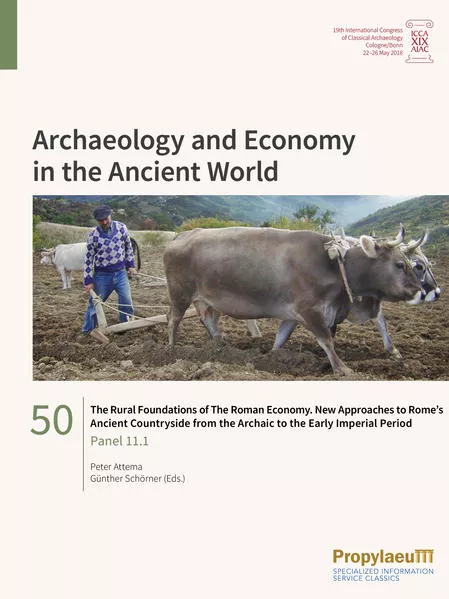Archaeology and Economy in the Ancient World
The Production and Distribution Network of the Bay of Naples: from a Regional to a Mediterranean Perspective
Chronologie aller Bände (1 - 8)

Die Reihenfolge beginnt mit dem Buch "Organizations of Production and Crafts in Pre-Roman Italy". Wer alle Bücher der Reihe nach lesen möchte, sollte mit diesem Band von Peter Attema beginnen. Die Reihe umfasst derzeit 8 Bände. Der neueste Band trägt den Titel "The Rural Foundations of The Roman Economy. New Approaches to Rome’s Ancient Countryside from the Archaic to the Early Imperial Period".
- Anzahl der Bewertungen für die gesamte Reihe: 0
- Ø Bewertung der Reihe: 0
Diese Reihenfolge enthält 8 unterschiedliche Autoren.
- Band: 11
- Autor: Burkhardt, Nadin
- Anzahl Bewertungen: 0
- Ø Bewertung:
- Medium: Buch
- Veröffentlicht: 14.12.2022
- Genre: Roman
Organizations of Production and Crafts in Pre-Roman Italy
While economic approaches are becoming generally more important and even mainstream topics, this is not necessarily the case for research into Pre-Roman Italy, defined as the area of the Italian Peninsula, Sicily and Sardinia during the Iron Age. Until recently, there was almost no research into Pre-Roman Italy focused on economic studies, and the existing research has been mostly dedicated to very specific contexts:
(1) specialization of crafts and production in the context of urbanization processes; (2) specific production areas, such as agriculture, metal processing, and salt production; (3) studies focusing on Greek Colonies and Greek Colonial encounters with indigenous populations; (4) analyses of consumption patterns, mainly in the case of Greek pottery consumption. Recent excavations and investigations devoted to the study of workshop structures, such as those at Gabii, Pithekoussai, Kroton, Lokroi Epizephyrioi, Naxos, Selinunt and Kyme / Cumae, have provided a range of new data that is stimulating a valuable and highly constructive discussion on the organization of production and crafts in Pre-Roman Italy. Against this background, four members of the study group ‘Etruscans and Italic Cultures’ from the ‘German Association of Archaeologists’ (Arbeitsgemeinschaft Etrusker und Italiker des DArV e.V.) formed a panel to discuss the economic aspects of Pre-Roman Italy on the basis of their ongoing research projects: all of these focus on the field of production and crafts. The aim is to contribute to an intensified debate on geographical, chronological and functional patterns in the organization of crafts and productions by discussing current case studies and methods.
(1) specialization of crafts and production in the context of urbanization processes; (2) specific production areas, such as agriculture, metal processing, and salt production; (3) studies focusing on Greek Colonies and Greek Colonial encounters with indigenous populations; (4) analyses of consumption patterns, mainly in the case of Greek pottery consumption. Recent excavations and investigations devoted to the study of workshop structures, such as those at Gabii, Pithekoussai, Kroton, Lokroi Epizephyrioi, Naxos, Selinunt and Kyme / Cumae, have provided a range of new data that is stimulating a valuable and highly constructive discussion on the organization of production and crafts in Pre-Roman Italy. Against this background, four members of the study group ‘Etruscans and Italic Cultures’ from the ‘German Association of Archaeologists’ (Arbeitsgemeinschaft Etrusker und Italiker des DArV e.V.) formed a panel to discuss the economic aspects of Pre-Roman Italy on the basis of their ongoing research projects: all of these focus on the field of production and crafts. The aim is to contribute to an intensified debate on geographical, chronological and functional patterns in the organization of crafts and productions by discussing current case studies and methods.
- Band: 24
- Autor: Schmidts, Thomas
- Anzahl Bewertungen: 0
- Ø Bewertung:
- Medium: Buch
- Veröffentlicht: 27.07.2022
- Genre: Roman
New Approaches to Seaborne Commerce in the Roman Empire
Seaborne commerce in the Roman Empire is characterised by a remarkable efficiency for the pre-modern world. From Egypt to Britain, trade connections can be proven on the basis of archaeological finds. The range of these activities includes the Mediterranean, the Black Sea and parts of the north-eastern Atlantic. Important reference points for the assessment of Roman merchant shipping are ports, ships and cargo remains. Due to the large number of known shipwrecks and ports, archaeology in particular can contribute to a better understanding of maritime trade.
The contributions address various aspects of the "seaborne commerce" with a broad methodological spectrum. In addition to wreck finds, the relevance of inscriptions on amphorae and other cargo remains are considered as well as the formation of networks, the reconstruction of ship routes and the performance of ancient watercraft based on experiments.
The contributions address various aspects of the "seaborne commerce" with a broad methodological spectrum. In addition to wreck finds, the relevance of inscriptions on amphorae and other cargo remains are considered as well as the formation of networks, the reconstruction of ship routes and the performance of ancient watercraft based on experiments.
- Band: 28
- Autor: Curtis, Michael J.
- Anzahl Bewertungen: 0
- Ø Bewertung:
- Medium: Buch
- Veröffentlicht: 06.07.2022
- Genre: Roman
Economy and the Maritime Cultural Landscape of Greece
In recent years new research and investigation along the coastlines has added to our understanding of the maritime cultures and traditions of ancient Greece. Even so, the maritime cultures, traditions and social aspects remain understudied and the traditional boundaries between terrestrial and underwater archaeology are still problematic and a challenge to researchers. Throughout time the settlements that stood beside the sea became increasingly important to local and regional economies, as they often benefitted from local, inter-island and cross-Mediterranean trade and the commercial and networking opportunities that this offered. Many of these settlements were the first point of contact for seafarers, travellers, and migrants, playing an important role in the diffusion of cultural, political, and religious ideologies.
The papers in this volume take us on a journey in time from an Early Bronze Age settlement on Paros to the Closed Harbours of Archaic and Classical Greece, and on to life in Hellenistic and Roman Crete. Whilst being preliminary perspectives, the contributions in this volume demonstrate the broad variance in subject material and offer an interesting insight into the world of maritime Greece.
The papers in this volume take us on a journey in time from an Early Bronze Age settlement on Paros to the Closed Harbours of Archaic and Classical Greece, and on to life in Hellenistic and Roman Crete. Whilst being preliminary perspectives, the contributions in this volume demonstrate the broad variance in subject material and offer an interesting insight into the world of maritime Greece.
- Band: 31
- Autor: Giglio, Marco
- Anzahl Bewertungen: 0
- Ø Bewertung:
- Medium: Buch
- Veröffentlicht: 06.07.2022
- Genre: Roman
The Production and Distribution Network of the Bay of Naples: from a Regional to a Mediterranean Perspective
Recent excavations on both production and consumption sites in Campania and international conferences on Roman pottery have given new impulses to the research on material culture and the regional and international pottery trade systems.
This volume analyses the circulation of pottery produced in the Bay of Naples between the late Republican and the early Imperial period from a double perspective: on one side the networks that transported pottery from the Bay to various points along the Mediterranean littoral; and on the other side the foods coming to Naples from various points in the Mediterranean.
The excavation contexts of Piazza Municipio in Naples, Puteoli and Herculaneum provide new relevant datasets both from the qualitative and quantitative point of view. This evidence highlights the strong relations of this area with the Eastern Mediterranean, especially in fine wares and transport containers - from the 2nd century BC Rhodian wine amphorai to 1st century AD Cretan products.
The area of the Magdalensberg imported Campanian Internal Red Slip ware as early as the late Republican period, and in especially high amounts in the Augustan age, when Campanian cooking wares are also attested in Aquileia, in northern Italy, the hotspot for the distribution of these vessels to the provinces of Northern Europe.
This volume analyses the circulation of pottery produced in the Bay of Naples between the late Republican and the early Imperial period from a double perspective: on one side the networks that transported pottery from the Bay to various points along the Mediterranean littoral; and on the other side the foods coming to Naples from various points in the Mediterranean.
The excavation contexts of Piazza Municipio in Naples, Puteoli and Herculaneum provide new relevant datasets both from the qualitative and quantitative point of view. This evidence highlights the strong relations of this area with the Eastern Mediterranean, especially in fine wares and transport containers - from the 2nd century BC Rhodian wine amphorai to 1st century AD Cretan products.
The area of the Magdalensberg imported Campanian Internal Red Slip ware as early as the late Republican period, and in especially high amounts in the Augustan age, when Campanian cooking wares are also attested in Aquileia, in northern Italy, the hotspot for the distribution of these vessels to the provinces of Northern Europe.
- Band: 37
- Autor: Parigi, Caterina
- Anzahl Bewertungen: 0
- Ø Bewertung:
- Medium: Buch
- Veröffentlicht: 23.02.2022
- Genre: Roman
Recycling and Reuse of Sculpture in Roman and Late Antique Times
Recycling and reuse of sculpture was a common practice in the ancient world, which took a variety of forms in different periods and places. The volume stresses two main aspects in relationship to this practice, namely the reuse of sculptures and their parts as building material on the one hand and in their original function or as works of art on the other hand. The reuse of sculpture has a number of socio-economical aspects. As the economic factor always plays an important role in recycling, it must always be taken into account. It is also important to remember the difficulty to purchase new sculptures in Late Antiquity. However, reuse and recycling are complex processes, which do not have a single cause and not only occur in Late Antiquity.
The reuse of statues may also have had an aesthetic value and been seen as a reminder of former times of glory. This volume focuses on the Roman and Late Antique periods, aiming to show the continuity and the complexity of the phenomenon. Through the comparison of different case studies in varying contexts, the papers highlight the common features and local singularities of this practice.
The reuse of statues may also have had an aesthetic value and been seen as a reminder of former times of glory. This volume focuses on the Roman and Late Antique periods, aiming to show the continuity and the complexity of the phenomenon. Through the comparison of different case studies in varying contexts, the papers highlight the common features and local singularities of this practice.
- Band: 38
- Autor: Zimmermann, Norbert
- Anzahl Bewertungen: 0
- Ø Bewertung:
- Medium: Buch
- Veröffentlicht: 21.09.2022
- Genre: Roman
The Economy of Death: New Research on Collective Burial Spaces in Rome from the Late Republic to the Late Roman Time
Die Beiträge dieses Bandes diskutieren wirtschaftliche Aspekte römischer Grabanlagen, die für eine größere Anzahl von Bestattungen ausgelegt sind, also etwa Kolumbarien, große Hypogäen oder Katakomben. Zugleich wird nach den Besitzern und Nutzern gefragt. Es wird untersucht, inwieweit wirtschaftliche Gründe bei der Erfindung, der Entwicklung und der Nutzung der großen Grabmonumente in Rom eine Rolle spielten und wie diese Bauten die religiösen und sozialen Bedürfnisse ihrer Auftraggeber bzw. der Bestatteten erfüllten, insbesondere in der Zeit des Übergangs von der römischen zur frühchristlichen Zeit. Jüngste Detailstudien zu den römischen Grabbauten lassen interessante Spuren des dynamischen Prozesses der Vorbereitung und Nutzung des Grabraumes dokumentieren, und speziell bei größeren Grabanlagen für weit mehr als eine einzige Familie ist der wirtschaftliche Aspekt von Besitz und Nutzung vielversprechend. Wer plante ein Bauvorhaben, wie und warum wurden ein bestimmter Ort und eine spezifische Architektur gewählt? Wie und wo im ursprünglichen Grabbau sah der Eigentümer für sich und seine Familie den eigenen Bestattungsplatz vor, und wo und auf welche Art und Weise wurden weitere Gräber verkauft oder sogar verschenkt? In den letzten Jahrzehnten mussten sich eine Reihe allgemeiner Studien zu römischen Bestattungen und Bestattungsbräuchen notwendigerweise auf ältere Dokumentationen stützen, während neue und detailliertere Analysen einzelner Monumente oft neue Erkenntnisse liefern und neue Interpretationen nahelegen.
- Band: 40
- Autor: Rieger, Anna-Katharina
- Anzahl Bewertungen: 0
- Ø Bewertung:
- Medium: Buch
- Veröffentlicht: 06.07.2022
- Genre: Roman
Cities, Resources and Religion – Economic Implications of Religion in Graeco-Roman Urban Environments
City and religion as subjects of archaeological research in the Mediterranean are often limited to sacred buildings within the spatial and social fabric of the city. However, specific urban factors such as the concentration of economic potential, control of financial resources, but also heterogeneous populations, marginalization, and power imbalances impact religious practices and their reflections in material culture.
The contributions in this volume discuss how economic characteristics of urbanity are reflected in institutional, medial, and performative expressions of religion(s) in cities of Italy and Asia Minor. These interactions are not only of interest for Greco-Roman antiquity, but are relevant in our modern world of globalized markets: With the concentration of economic power the potential for tensions and religious conflicts increases as rapidly as cities grow.
The contributions in this volume discuss how economic characteristics of urbanity are reflected in institutional, medial, and performative expressions of religion(s) in cities of Italy and Asia Minor. These interactions are not only of interest for Greco-Roman antiquity, but are relevant in our modern world of globalized markets: With the concentration of economic power the potential for tensions and religious conflicts increases as rapidly as cities grow.
- Band: 50
- Autor: Attema, Peter
- Anzahl Bewertungen: 0
- Ø Bewertung:
- Medium: Buch
- Veröffentlicht: 19.01.2022
- Genre: Roman
The Rural Foundations of The Roman Economy. New Approaches to Rome’s Ancient Countryside from the Archaic to the Early Imperial Period
The aim of the AIAC 2018 session “The Rural Foundations of the Roman Economy, new approaches to Rome's ancient countryside from the Archaic to the Early Imperial period” was to bring together methodologically informed, data-driven studies to shed light on the drivers and performance of the Central Italian rural economy during the Archaic to Imperial periods. The session resulted in a coherent collection of papers by a broad range of international scholars in the field who approach the Roman agricultural economy from various disciplinary angles and at different scales. The collection has a sharp focus on the suburbium of Rome sensu lato. Topics range from rural settlement dispersal, economic and demographic modelling to survey artefact analysis and the study of pollen and plant macro-remains.
